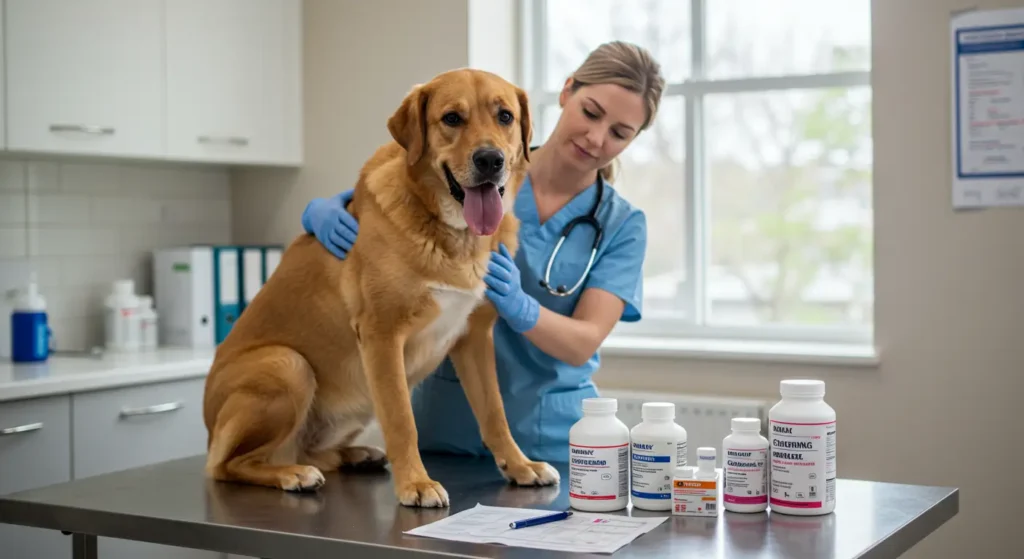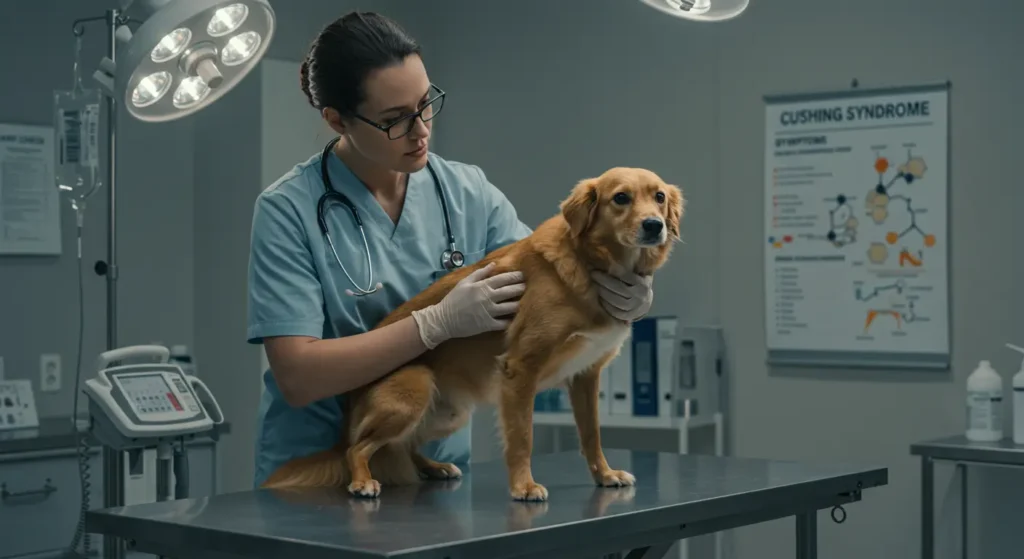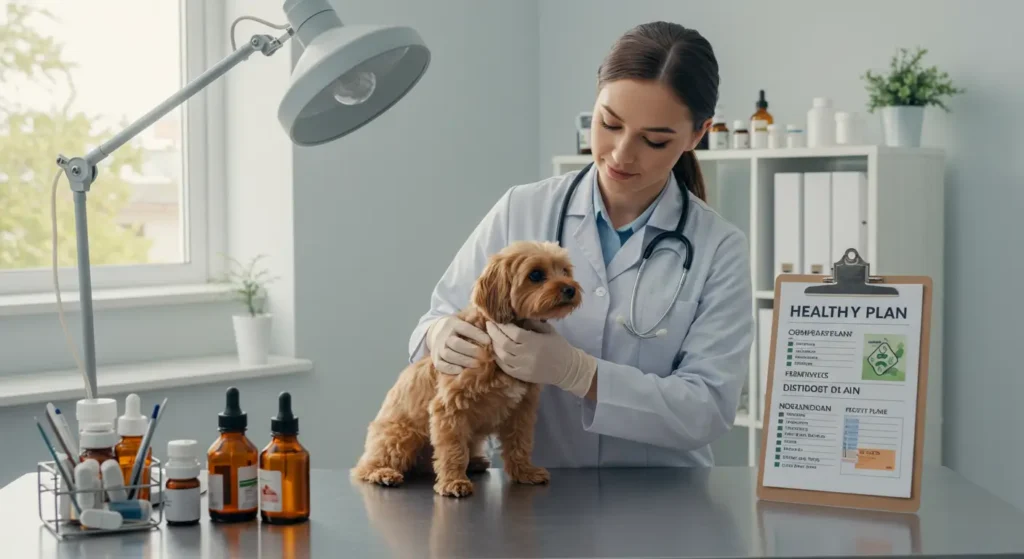As a dog owner, you know how vital your dog’s health is. With 53% of dog owners worried about their pet’s health weekly, Cushing’s syndrome is a big worry. This condition can make a dog’s back legs weak, a common sign of canine Cushing’s disease.
Cushing’s syndrome can lead to muscle weakness in dogs. It’s important to know how it affects a dog’s back legs. This knowledge helps in understanding and managing the condition.
Table of Contents
Cushing’s syndrome often hits older dogs, over 6 years old. Some breeds are more prone to it. If your dog struggles with stairs or seems weak, it might have Cushing’s syndrome. Seeing a vet is key to figuring out what’s wrong and finding the right treatment.
Understanding Cushing Syndrome in Dogs
As a dog owner, knowing about Cushing syndrome is key. It’s a condition that affects many dogs, especially those over 6 years old. It’s caused by a tumor on the pituitary or adrenal gland. Signs like too much thirst, urination, and hunger might mean your dog has it.
For cushings treatment for dogs, you need to team up with your vet. They’ll figure out the best way to help your dog. Knowing the canine cushings disease symptoms is crucial for the right diagnosis and treatment.
Some important facts to remember:
- Cushing’s syndrome often hits dogs over 6 years old.
- Females are more likely to get it than males.
- Some breeds like Miniature Poodles and Cocker Spaniels are at higher risk.
What is Cushing Syndrome?
Cushing syndrome is a complex issue. It can be caused by tumors on the pituitary or adrenal gland.
Types of Cushing Syndrome
There are two main types: pituitary-dependent and adrenal-dependent. Pituitary-dependent Cushing’s is the most common, making up 80-90% of cases.
Risk Factors and Prevalence
Some breeds and ages are more likely to get Cushing’s syndrome. Knowing these risk factors helps spot symptoms early and get vet care fast.
The Connection Between Cushing Syndrome and Dog Back Leg Weakness
As dogs get older, they might get Cushing’s syndrome more often. This can make dog back leg weakness worse. The extra cortisol from the adrenal glands can cause weight gain, more thirst and urination, and muscle weakness. This syndrome can really affect a dog’s back legs, making them weak and wasting muscle.
Some important things to think about with Cushing syndrome and dog back leg weakness are:
- Excessive thirst and urination
- Increased appetite
- Lethargy and behavioral changes
- Muscle weakness, particularly in the back legs
It’s very important to take your dog to the vet regularly. This helps keep an eye on their health and make any needed changes to their treatment. With the right care, dogs with Cushing’s syndrome can still live happy and healthy lives, even with dog back leg weakness and other symptoms.
| Symptom | Description |
|---|---|
| Excessive thirst and urination | Increased water intake and frequent urination |
| Muscle weakness | Weakness in the back legs, making it difficult to walk or climb stairs |
| Lethargy and behavioral changes | Increased sleeping time, changes in appetite, and other behavioral changes |
Common Symptoms of Canine Cushing Syndrome
As a dog owner, knowing the signs of canine Cushing syndrome is key. It helps in quick diagnosing cushings in dogs and starting the right canine cushings disease treatment. This condition mainly hits dogs over 6 years old, especially females. Breeds like Miniature Poodles and Cocker Spaniels are at higher risk.
Look out for physical signs like weight gain, thin skin, and hair loss. Behavioral changes, like drinking more water and going to the bathroom more, are also signs. Managing cushings in dogs means using medicine, making lifestyle changes, and keeping a close eye on them. Here are some common symptoms:
- Increased appetite and water consumption
- Urinary tract infections and incontinence
- Muscle weakness and wasting, especially in the hind legs
- Thin, fragile skin and a poor hair coat
Knowing these symptoms is vital for diagnosing and treating your dog. By spotting the signs early, you and your vet can create a treatment plan. This ensures your dog gets the best care possible.

Diagnosing Cushing Syndrome in Your Dog
Figuring out if your dog has Cushing’s syndrome can be tough. Vets use blood and urine tests, and imaging like X-rays and ultrasound. These tools help them find out if your dog has this condition.
Some signs of Cushing’s in dogs include drinking a lot of water, going to the bathroom a lot, and having a big belly. They might also have weak muscles. This makes it hard for older dogs to move around.
Here are some important things to know when checking for Cushing’s syndrome:
- Age: It usually happens in dogs over 6 years old.
- Breed: Some dogs like Miniature Poodles and Dachshunds get it more often.
- Sex: More female dogs have Cushing’s syndrome than males.
About 60%-70% of dogs with Cushing’s drink a lot of water and pee a lot. Around 40% have weak muscles. Knowing these facts helps you and your vet figure out how to deal with it.

| Test | Description | Accuracy Rate |
|---|---|---|
| Blood and Urine Tests | Measure cortisol levels and other hormones | 85-90% |
| Imaging Tests (X-rays and Ultrasound) | Visualize internal organs and tumors | 80-90% |
Treatment Options for Dogs with Cushing Syndrome
As a dog owner, it’s key to know the treatment options for dogs with Cushing’s. If your dog has Cushing’s, your vet will help create a treatment plan. The main goal is to manage symptoms and slow the disease’s progress.
There are different treatments like medication, surgery, or a mix of both. Medicines like trilostane or mitotane can lower cortisol levels. Surgery might be needed to remove tumors. You can also try alternative therapies like acupuncture and herbal remedies to help manage symptoms.
It’s important to work closely with your vet to find the best treatment for your dog. Regular check-ups and care are crucial to make sure the treatment works well. Knowing the treatment options helps you make the best decisions for your dog’s care and happiness.

The following table summarizes the treatment options for dogs with Cushing syndrome:
| Treatment Option | Description |
|---|---|
| Medication | Reduces cortisol production |
| Surgery | Removes tumors |
| Alternative Therapies | Manages symptoms |
By working with your vet and exploring treatment options, you can help your dog with Cushing’s manage their symptoms. This improves their quality of life.
Managing Your Dog’s Back Leg Weakness
As a dog owner, it’s key to know how to handle dog back leg weakness. Dealing with managing Cushing’s in dogs means using home care, making changes to the environment, and exercising them right.
First, make sure your dog has a comfy place to rest. A soft, orthopedic bed can help a lot. Also, ramps and stairs can ease the strain on their back legs.
Home Care Tips
- Provide a comfortable and supportive environment
- Assist with mobility issues
- Monitor your dog’s condition and adjust care accordingly
Exercise Recommendations
Short walks can keep your dog’s back legs strong and mobile. But, don’t push them too hard. Talk to your vet to find the right exercise for your dog.
By following these tips and getting advice from your vet, you can help your dog feel better. Always put your dog’s comfort first and seek help if you’re worried about their health.
| Condition | Symptoms | Treatment |
|---|---|---|
| Cushing’s Syndrome | Muscle weakness, back leg weakness | Medication, surgery, lifestyle changes |
| Intervertebral Disc Disease (IVDD) | Back pain, hind leg weakness | Surgery, physical therapy, lifestyle changes |
Preventing Complications in Dogs with Cushing Syndrome
As a dog owner, it’s key to manage cushings in dogs to prevent complications. This ensures your pet lives a longer, healthier life. Treatment for canine cushings disease includes regular checks on blood sugar and liver enzymes. It also involves managing other health issues that might be present.
Some important strategies for preventing complications include:
- Regular veterinary check-ups to monitor treatment efficacy and complications
- Dietary interventions to manage weight and reduce the risk of musculoskeletal disorders
- Pain management strategies to improve mobility and reduce pain
By working closely with your vet and following a detailed treatment plan, you can prevent complications. This may involve medication to manage symptoms. It also includes lifestyle changes to lower the risk of related health problems.
With the right care and attention, dogs with Cushing syndrome can live happy, healthy lives. By focusing on your dog’s health and well-being, you can prevent complications. This ensures a strong, loving bond between you and your pet.
| Strategy | Description |
|---|---|
| Regular monitoring | Regular veterinary check-ups to monitor treatment efficacy and complications |
| Dietary interventions | Managing weight and reducing the risk of musculoskeletal disorders through dietary changes |
| Pain management | Improving mobility and reducing pain through pain management strategies |
Working with Your Veterinarian for Long-term Care
Managing your dog’s Cushing’s syndrome requires teamwork with your vet. Regular check-ups and adjusting treatment plans are key for canine cushings disease treatment. This teamwork helps your dog live a better life.
Long-term care includes diagnosing cushings in dogs and creating a treatment plan. This might include medication, lifestyle changes, and regular vet visits. Your vet guides you through this process, helping you make the best choices for your dog.
Managing Cushing’s in dogs needs a full approach. This considers your dog’s health, lifestyle, and needs. Working with your vet ensures your dog thrives and enjoys a better life. Important steps include:
- Regular monitoring and adjusting treatment plans as needed
- Providing a healthy diet and lifestyle for your dog’s well-being
- Staying updated on canine cushings disease treatment and diagnosing cushings in dogs
By following these steps and working with your vet, you can help your dog manage Cushing’s syndrome. This way, your dog can live a longer, healthier life.
| Treatment Option | Description |
|---|---|
| Medication | Medications like mitotane, trilostane, and selegiline help control Cushing’s symptoms |
| Surgery | Surgery can remove tumors causing Cushing’s syndrome |
| Lifestyle Changes | A healthy diet and lifestyle, including exercise and a balanced diet, support your dog’s well-being |
Conclusion
Cushing’s syndrome in dogs can be tough, but with the right care, your dog can get better. Working with your vet is key to finding the best treatment. This helps fix the hormonal issues and ease the symptoms.
Keeping a close eye on your dog and adjusting their care as needed is important. This ensures they live a happy life despite the challenges. With the right support, your dog can thrive. This article has given you the tools to help your dog stay healthy and happy.

